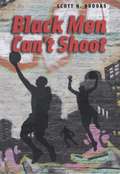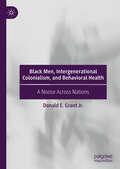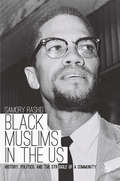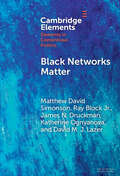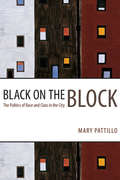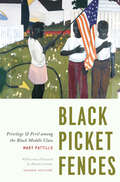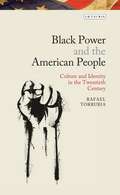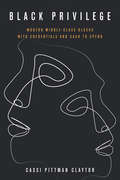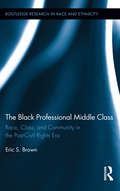- Table View
- List View
Black Men, Black Feminism: Lucifer's Nocturne
by Jared SextonA brief commentary on the necessity and the impossibility of black men’s participation in the development of black feminist theory and politics, Black Men, Black Feminism examines the basic assumptions that have guided—and misguided—black men’s efforts to take up black feminism. Offering a rejoinder to the contemporary study of black men and masculinity in the twenty-first century, Jared Sexton interrogates some of the most common intellectual postures of black men writing about black feminism, ultimately departing from the prevailing discourse on progressive black masculinities. Sexton examines, by contrast, black men’s critical and creative work—from Charles Burnett’s Killer of Sheep to Jordan Peele’s Get Out— to describe the cultural logic that provides a limited moral impetus to the quest for black male feminism and that might, if reconfigured, prompt an ethical response of an entirely different order.
Black Men Can't Shoot
by Scott N. BrooksThe myth of the natural black athlete is widespread, though it’s usually talked about only when a sports commentator or celebrity embarrasses himself by bringing it up in public. Those gaffes are swiftly decried as racist, but apart from their link to the long history of ugly racial stereotypes about black people—especially men—they are also harmful because they obscure very real, hard-fought accomplishments. As Black Men Can’t Shoot demonstrates, such successes on the basketball court don’t happen just because of natural gifts—instead, they grow out of the long, tough, and unpredictable process of becoming a known player. Scott Norman Brooks spent four years coaching summer league basketball in Philadelphia. And what he saw, heard, and felt working with the young black men on his team tells us much about how some kids are able to make the extraordinary journey from the ghetto to the NCAA. He tells the story of two young men, Jermaine and Ray, following them through their high school years and chronicling their breakthroughs and frustrations on the court as well as their troubles at home. Black Men Can’t Shoot is a moving coming-of-age story that counters the belief that basketball only exploits kids and lures them into following empty dreams—and shows us that by playing ball, some of these young black men have already begun their education even before they get to college.
Black Men Can't Shoot
by Scott N. BrooksThe myth of the natural black athlete is widespread, though it’s usually talked about only when a sports commentator or celebrity embarrasses himself by bringing it up in public. Those gaffes are swiftly decried as racist, but apart from their link to the long history of ugly racial stereotypes about black people—especially men—they are also harmful because they obscure very real, hard-fought accomplishments. As Black Men Can’t Shoot demonstrates, such successes on the basketball court don’t happen just because of natural gifts—instead, they grow out of the long, tough, and unpredictable process of becoming a known player. Scott Norman Brooks spent four years coaching summer league basketball in Philadelphia. And what he saw, heard, and felt working with the young black men on his team tells us much about how some kids are able to make the extraordinary journey from the ghetto to the NCAA. He tells the story of two young men, Jermaine and Ray, following them through their high school years and chronicling their breakthroughs and frustrations on the court as well as their troubles at home. Black Men Can’t Shoot is a moving coming-of-age story that counters the belief that basketball only exploits kids and lures them into following empty dreams—and shows us that by playing ball, some of these young black men have already begun their education even before they get to college.
Black Men Can't Shoot
by Scott N. BrooksThe myth of the natural black athlete is widespread, though it’s usually talked about only when a sports commentator or celebrity embarrasses himself by bringing it up in public. Those gaffes are swiftly decried as racist, but apart from their link to the long history of ugly racial stereotypes about black people—especially men—they are also harmful because they obscure very real, hard-fought accomplishments. As Black Men Can’t Shoot demonstrates, such successes on the basketball court don’t happen just because of natural gifts—instead, they grow out of the long, tough, and unpredictable process of becoming a known player. Scott Norman Brooks spent four years coaching summer league basketball in Philadelphia. And what he saw, heard, and felt working with the young black men on his team tells us much about how some kids are able to make the extraordinary journey from the ghetto to the NCAA. He tells the story of two young men, Jermaine and Ray, following them through their high school years and chronicling their breakthroughs and frustrations on the court as well as their troubles at home. Black Men Can’t Shoot is a moving coming-of-age story that counters the belief that basketball only exploits kids and lures them into following empty dreams—and shows us that by playing ball, some of these young black men have already begun their education even before they get to college.
Black Men in Britain: An Ethnographic Portrait of the Post-Windrush Generation (Routledge Advances in Ethnography)
by Kenny MonroseWhile extensive attention has been paid to black youth, adult black British men are a notable omission in academic literature. This book is the first attempt to understand one of Britain’s hidden populations: the post-Windrush generation, who matured within a post-industrial British society that rendered them both invisible and irrelevant. Using ethnography, participant observation, interviews and his own personal experience, and without an ounce of liberal angst, Kenny Monrose pulls no punches and presents the reader with a fierce but sensitive study of a population that has been vilified and ignored. The widely disseminated portrait of black maleness, which habitually constructs black men as being either violently dangerous, or social failures, is challenged by granting black men in Britain the autonomy to speak on sociologically significant issues candidly and openly for themselves. This reveals how this group has been forced to negotiate a glut of political shifts and socially imposed imperatives, ranging from Windrush to Brexit, and how these have had an impact on their life course. This provides a cultural uplift and offers an authenticated examination and privileged insight of black British culture. This book will be of interest to sociologists, cultural historians and criminologists engaged with citizenship, migration, race, racialisation and criminal justice.
Black Men in Britain: An Ethnographic Portrait of the Post-Windrush Generation (Routledge Advances in Ethnography)
by Kenny MonroseWhile extensive attention has been paid to black youth, adult black British men are a notable omission in academic literature. This book is the first attempt to understand one of Britain’s hidden populations: the post-Windrush generation, who matured within a post-industrial British society that rendered them both invisible and irrelevant. Using ethnography, participant observation, interviews and his own personal experience, and without an ounce of liberal angst, Kenny Monrose pulls no punches and presents the reader with a fierce but sensitive study of a population that has been vilified and ignored. The widely disseminated portrait of black maleness, which habitually constructs black men as being either violently dangerous, or social failures, is challenged by granting black men in Britain the autonomy to speak on sociologically significant issues candidly and openly for themselves. This reveals how this group has been forced to negotiate a glut of political shifts and socially imposed imperatives, ranging from Windrush to Brexit, and how these have had an impact on their life course. This provides a cultural uplift and offers an authenticated examination and privileged insight of black British culture. This book will be of interest to sociologists, cultural historians and criminologists engaged with citizenship, migration, race, racialisation and criminal justice.
Black Men, Intergenerational Colonialism, and Behavioral Health: A Noose Across Nations
by Donald E. Grant Jr.This book provides an in-depth historical exploration of the risk and protective factors that generate disproportionality in the psychological wellness, somatic health, and general safety of Black men in four industrialized Euronormative nations. It provides a detailed analysis of how nationalism, globalism, colonialism, and imperialism have facilitated practices, philosophies, and policies to support the development and maintenance of inter-generational systems of oppression for Black men and boys. The text juxtaposes empirically-supported constructs like historical trauma and epigenetics with current outcomes for Black men in the US, the UK, France and Canada. It details how contemporary institutions, practices, and policies (such as psychological testing, the school to prison pipeline, and over-incarceration) are reiterations of historic ones (such as convict leasing, debt peonage, and the Jim Crow laws). The text uses paleontological, archaeological, and anthropological research to cover over 200,000 years of history. It closes with strength-based paradigms aimed to dismantle oppressive structures, support the post-traumatic growth of Black men and boys, and enhance the systems and practitioners that serve them.
Black Men Worshipping: Intersecting Anxieties of Race, Gender, and Christian Embodiment (Black Religion/Womanist Thought/Social Justice)
by S. BoydBlack Men Worshipping analyzes the discursive spaces where Black masculinity is constructed, performed, and contested in American religion and culture. It judiciously considers the anxiety that emerges from Black male negotiations with these constructions
Black Metropolis: A Study of Negro Life in a Northern City
by St. Clair Drake Horace R. CaytonGround-breaking when first published in 1945, Black Metropolis remains a landmark study of race and urban life. Few studies since have been able to match its scope and magnitude, offering one of the most comprehensive looks at black life in America. Based on research conducted by Works Progress Administration field workers, it is a sweeping historical and sociological account of the people of Chicago's South Side from the 1840s through the 1930s. Its findings offer a comprehensive analysis of black migration, settlement, community structure, and black-white race relations in the first half of the twentieth century. It offers a dizzying and dynamic world filled with captivating people and startling revelations. A new foreword from sociologist Mary Pattillo places the study in modern context, updating the story with the current state of black communities in Chicago and the larger United States and exploring what this means for the future. As the country continues to struggle with race and our treatment of black lives, Black Metropolis continues to be a powerful contribution to the conversation.
Black Metropolis: A Study of Negro Life in a Northern City
by St. Clair Drake Horace R. CaytonGround-breaking when first published in 1945, Black Metropolis remains a landmark study of race and urban life. Few studies since have been able to match its scope and magnitude, offering one of the most comprehensive looks at black life in America. Based on research conducted by Works Progress Administration field workers, it is a sweeping historical and sociological account of the people of Chicago's South Side from the 1840s through the 1930s. Its findings offer a comprehensive analysis of black migration, settlement, community structure, and black-white race relations in the first half of the twentieth century. It offers a dizzying and dynamic world filled with captivating people and startling revelations. A new foreword from sociologist Mary Pattillo places the study in modern context, updating the story with the current state of black communities in Chicago and the larger United States and exploring what this means for the future. As the country continues to struggle with race and our treatment of black lives, Black Metropolis continues to be a powerful contribution to the conversation.
Black Metropolis: A Study of Negro Life in a Northern City
by St. Clair Drake Horace R. CaytonGround-breaking when first published in 1945, Black Metropolis remains a landmark study of race and urban life. Few studies since have been able to match its scope and magnitude, offering one of the most comprehensive looks at black life in America. Based on research conducted by Works Progress Administration field workers, it is a sweeping historical and sociological account of the people of Chicago's South Side from the 1840s through the 1930s. Its findings offer a comprehensive analysis of black migration, settlement, community structure, and black-white race relations in the first half of the twentieth century. It offers a dizzying and dynamic world filled with captivating people and startling revelations. A new foreword from sociologist Mary Pattillo places the study in modern context, updating the story with the current state of black communities in Chicago and the larger United States and exploring what this means for the future. As the country continues to struggle with race and our treatment of black lives, Black Metropolis continues to be a powerful contribution to the conversation.
Black Metropolis: A Study of Negro Life in a Northern City
by St. Clair Drake Horace R. CaytonGround-breaking when first published in 1945, Black Metropolis remains a landmark study of race and urban life. Few studies since have been able to match its scope and magnitude, offering one of the most comprehensive looks at black life in America. Based on research conducted by Works Progress Administration field workers, it is a sweeping historical and sociological account of the people of Chicago's South Side from the 1840s through the 1930s. Its findings offer a comprehensive analysis of black migration, settlement, community structure, and black-white race relations in the first half of the twentieth century. It offers a dizzying and dynamic world filled with captivating people and startling revelations. A new foreword from sociologist Mary Pattillo places the study in modern context, updating the story with the current state of black communities in Chicago and the larger United States and exploring what this means for the future. As the country continues to struggle with race and our treatment of black lives, Black Metropolis continues to be a powerful contribution to the conversation.
Black middle-class Britannia: Identities, repertoires, cultural consumption (Racism, Resistance and Social Change)
by Ali MeghjiThis book analyses how racism and anti-racism affect Black British middle class cultural consumption. The author argues there are three black middle class identity modes: strategic assimilation, class- minded, and ethnoracial autonomous. People towards each of these identity modes organise their cultural consumption according to specific cultural repertoires. Those towards strategic assimilation draw on repertoires of code-switching and cultural equity, consuming traditional middle class culture to maintain equality with the white middle class in levels of cultural capital. Ethnoracial autonomous individuals draw on repertoires of browning and Afro-centrism, showing a preference for cultural forms that uplift Black diasporic histories and cultures.
Black middle-class Britannia: Identities, repertoires, cultural consumption (Racism, Resistance and Social Change)
by Ali MeghjiThis book analyses how racism and anti-racism affect Black British middle class cultural consumption. The author argues there are three black middle class identity modes: strategic assimilation, class- minded, and ethnoracial autonomous. People towards each of these identity modes organise their cultural consumption according to specific cultural repertoires. Those towards strategic assimilation draw on repertoires of code-switching and cultural equity, consuming traditional middle class culture to maintain equality with the white middle class in levels of cultural capital. Ethnoracial autonomous individuals draw on repertoires of browning and Afro-centrism, showing a preference for cultural forms that uplift Black diasporic histories and cultures.
Black Muslims in the US: History, Politics, and the Struggle of a Community
by S. RashidBlack Muslims in the U.S. seeks to address deficiencies in current scholarship about black Muslims in American society, from examining the origins of Islam among African-Americans to acknowledging the influential role that black Muslims play in contemporary U.S. society.
Black Networks Matter: The Role of Interracial Contact and Social Media in the 2020 Black Lives Matter Protests (Elements in Contentious Politics)
by null Matthew David Simonson null Ray Block Jr null James N. Druckman null Katherine Ognyanova null David M. LazerScholars have long recognized that interpersonal networks play a role in mobilizing social movements. Yet, many questions remain. This Element addresses these questions by theorizing about three dimensions of ties: emotionally strong or weak, movement insider or outsider, and ingroup or cross-cleavage. The survey data on the 2020 Black Lives Matter protests show that weak and cross-cleavage ties among outsiders enabled the movement to evolve from a small provocation into a massive national mobilization. In particular, the authors find that Black people mobilized one another through social media and spurred their non-Black friends to protest by sharing their personal encounters with racism. These results depart from the established literature regarding the civil rights movement that emphasizes strong, movement-internal, and racially homogenous ties. The networks that mobilize appear to have changed in the social media era. This title is also available as Open Access on Cambridge Core.
Black on the Block: The Politics of Race and Class in the City
by Mary PattilloIn Black on the Block, Mary Pattillo—a Newsweek Woman of the 21st Century—uses the historic rise, alarming fall, and equally dramatic renewal of Chicago’s North Kenwood–Oakland neighborhood to explore the politics of race and class in contemporary urban America. There was a time when North Kenwood–Oakland was plagued by gangs, drugs, violence, and the font of poverty from which they sprang. But in the late 1980s, activists rose up to tackle the social problems that had plagued the area for decades. Black on the Block tells the remarkable story of how these residents laid the groundwork for a revitalized and self-consciously black neighborhood that continues to flourish today. But theirs is not a tale of easy consensus and political unity, and here Pattillo teases out the divergent class interests that have come to define black communities like North Kenwood–Oakland. She explores the often heated battles between haves and have-nots, home owners and apartment dwellers, and newcomers and old-timers as they clash over the social implications of gentrification. Along the way, Pattillo highlights the conflicted but crucial role that middle-class blacks play in transforming such districts as they negotiate between established centers of white economic and political power and the needs of their less fortunate black neighbors. “A century from now, when today's sociologists and journalists are dust and their books are too, those who want to understand what the hell happened to Chicago will be finding the answer in this one.”—Chicago Reader “To see how diversity creates strange and sometimes awkward bedfellows . . . turn to Mary Pattillo's Black on the Block.”—Boston Globe
Black Picket Fences, Second Edition: Privilege and Peril among the Black Middle Class
by Mary PattilloFirst published in 1999, Mary Pattillo’s Black Picket Fences explores an American demographic group too often ignored by both scholars and the media: the black middle class. Nearly fifteen years later, this book remains a groundbreaking study of a group still underrepresented in the academic and public spheres. The result of living for three years in “Groveland,” a black middle-class neighborhood on Chicago’s South Side, Black Picket Fences explored both the advantages the black middle class has and the boundaries they still face. Despite arguments that race no longer matters, Pattillo showed a different reality, one where black and white middle classes remain separate and unequal. Stark, moving, and still timely, the book is updated for this edition with a new epilogue by the author that details how the neighborhood and its residents fared in the recession of 2008, as well as new interviews with many of the same neighborhood residents featured in the original. Also included is a new foreword by acclaimed University of Pennsylvania sociologist Annette Lareau.
Black Picket Fences, Second Edition: Privilege and Peril among the Black Middle Class
by Mary PattilloFirst published in 1999, Mary Pattillo’s Black Picket Fences explores an American demographic group too often ignored by both scholars and the media: the black middle class. Nearly fifteen years later, this book remains a groundbreaking study of a group still underrepresented in the academic and public spheres. The result of living for three years in “Groveland,” a black middle-class neighborhood on Chicago’s South Side, Black Picket Fences explored both the advantages the black middle class has and the boundaries they still face. Despite arguments that race no longer matters, Pattillo showed a different reality, one where black and white middle classes remain separate and unequal. Stark, moving, and still timely, the book is updated for this edition with a new epilogue by the author that details how the neighborhood and its residents fared in the recession of 2008, as well as new interviews with many of the same neighborhood residents featured in the original. Also included is a new foreword by acclaimed University of Pennsylvania sociologist Annette Lareau.
Black Picket Fences, Second Edition: Privilege and Peril among the Black Middle Class
by Mary PattilloFirst published in 1999, Mary Pattillo’s Black Picket Fences explores an American demographic group too often ignored by both scholars and the media: the black middle class. Nearly fifteen years later, this book remains a groundbreaking study of a group still underrepresented in the academic and public spheres. The result of living for three years in “Groveland,” a black middle-class neighborhood on Chicago’s South Side, Black Picket Fences explored both the advantages the black middle class has and the boundaries they still face. Despite arguments that race no longer matters, Pattillo showed a different reality, one where black and white middle classes remain separate and unequal. Stark, moving, and still timely, the book is updated for this edition with a new epilogue by the author that details how the neighborhood and its residents fared in the recession of 2008, as well as new interviews with many of the same neighborhood residents featured in the original. Also included is a new foreword by acclaimed University of Pennsylvania sociologist Annette Lareau.
Black Picket Fences, Second Edition: Privilege and Peril among the Black Middle Class
by Mary PattilloFirst published in 1999, Mary Pattillo’s Black Picket Fences explores an American demographic group too often ignored by both scholars and the media: the black middle class. Nearly fifteen years later, this book remains a groundbreaking study of a group still underrepresented in the academic and public spheres. The result of living for three years in “Groveland,” a black middle-class neighborhood on Chicago’s South Side, Black Picket Fences explored both the advantages the black middle class has and the boundaries they still face. Despite arguments that race no longer matters, Pattillo showed a different reality, one where black and white middle classes remain separate and unequal. Stark, moving, and still timely, the book is updated for this edition with a new epilogue by the author that details how the neighborhood and its residents fared in the recession of 2008, as well as new interviews with many of the same neighborhood residents featured in the original. Also included is a new foreword by acclaimed University of Pennsylvania sociologist Annette Lareau.
Black Power and the American People: Culture and Identity in the Twentieth Century (Library of Modern American History)
by Rafael TorrubiaWhile the history of the Civil Rights Movement, from Rosa Parks to Martin Luther King, is one of the great American stories of the twentieth century, the related Black Power movement has left a more complex legacy. Its original leaders, Stokely Carmichael and Willie Ricks, were Black Nationalists, advocating a militant and extremist approach to tackle racism, while other leaders, such as Bobby Seale of the Black Panthers, believed that the struggle for Black Power was essentially a class struggle. Beginning with the folk-narratives told through song by slaves in the plantations, through the Harlem renaissance of the 1920s and 30s, the era of Malcolm X, the African-American art and fashion of the late sixties and 'soul music' and politics in the 1970s, Black Power and the American People will be the first comprehensive cultural history of the movement.
Black Privilege: Modern Middle-Class Blacks with Credentials and Cash to Spend (Culture and Economic Life)
by Cassi Pittman ClaytorIn their own words, the subjects of this book present a rich portrait of the modern black middle-class, examining how cultural consumption is a critical tool for enjoying material comforts as well as challenging racism. New York City has the largest population of black Americans out of any metropolitan area in the United States. It is home to a steadily rising number of socio-economically privileged blacks. In Black Privilege Cassi Pittman Claytor examines how this economically advantaged group experiences privilege, having credentials that grant them access to elite spaces and resources with which they can purchase luxuries, while still confronting persistent anti-black bias and racial stigma. Drawing on the everyday experiences of black middle-class individuals, Pittman Claytor offers vivid accounts of their consumer experiences and cultural flexibility in the places where they live, work, and play. Whether it is the majority white Wall Street firm where they're employed, or the majority black Baptist church where they worship, questions of class and racial identity are equally on their minds. They navigate divergent social worlds that demand, at times, middle-class sensibilities, pedigree, and cultural acumen; and at other times pride in and connection with other blacks. Rich qualitative data and original analysis help account for this special kind of privilege and the entitlements it affords—materially in terms of the things they consume, as well as symbolically, as they strive to be unapologetically black in a society where a racial consumer hierarchy prevails.
The Black Professional Middle Class: Race, Class, and Community in the Post-Civil Rights Era (Routledge Research in Race and Ethnicity #8)
by Eric S. BrownThrough an in-depth case study of the black professional middle class in Oakland, this book provides an analysis of the experiences of black professionals in the workplace, community, and local politics. Brown shows how overlapping dynamics of class formation and racial formation have produced historically powerful processes of what he terms "racialized class formation," resulting in a distinct (and internally differentiated) entity, not merely a subset of a larger professional middle class.
The Black Professional Middle Class: Race, Class, and Community in the Post-Civil Rights Era (Routledge Research in Race and Ethnicity)
by Eric S. BrownThrough an in-depth case study of the black professional middle class in Oakland, this book provides an analysis of the experiences of black professionals in the workplace, community, and local politics. Brown shows how overlapping dynamics of class formation and racial formation have produced historically powerful processes of what he terms "racialized class formation," resulting in a distinct (and internally differentiated) entity, not merely a subset of a larger professional middle class.

